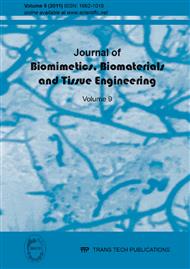[1]
P. Broos, A. Sermon, Acta. Chir. Belg., Vol. 104 (2004), pp.396-400.
Google Scholar
[2]
L. Richard & D. Rudy, Veterinary Surgery, Vol. 3 (1974) p.23–27.
Google Scholar
[3]
D. Cumming, N. Mfula, J. Jones, Int Orthop., Vol. 32 (2008), p.421–423.
Google Scholar
[4]
M. Khazzam, C. Tassone, X. Liu, R. Lyon, B. Freeto, J. Schwab, J. Thometz, Am J Orthop., Vol. 38 (2009), E49-E55.
Google Scholar
[5]
I. Huber , H. Keller, P. Huber, K. Rehm, J Pediatr Orthop, Vol. 16 (1996), pp.602-5.
Google Scholar
[6]
I. Sinisaari, PhD Dissertation, Helsinki University Central Hospital, (2004).
Google Scholar
[7]
W. Ciccone, C. Motz, C. Bentley, J. Tasto, J. Am. Acad. Orthop. S. Vol. 9 (2001) pp.280-288.
Google Scholar
[8]
H. Pihlajamaki, E. Makela, N. Ashammakhi, J. Viljanen, H. Patiala, P. Rokkanen, J. Mat. Sci.: Mats Med., Vol. 13 (2002), pp.389-395.
Google Scholar
[9]
J. Vasenius, S. Vainionpaa, K. Vihtonen, A. Makela, P. Rokkanen, Biomaterials Vol. 11 (1990), p.501 – 504.
Google Scholar
[10]
S. Santavirta, Y. Konttinen, T. Saito, M. Gronblad, E. Partio, P. Kemppinen, P. Rokkanen, J. Bone Joint Surg., (Vol 72B), pp.597-600.
DOI: 10.1302/0301-620x.72b4.2166048
Google Scholar
[11]
O. Bostman, H. Pihlajamaki, Clinical Orthopaedics and Related Research, Vol. 371 (2000) pp.216-227.
Google Scholar
[12]
H. Pihlajamaki, S. Salminen, O. Laitlinen, O. Tynninen, O. Bostman, J. Orth. Res. , Vol. 24 (2006), p.1597–1606.
Google Scholar
[13]
H. Miettinen, A. Makela, P. Rokkanen, P. Tormala, J. Vainio, Clin. Mat. Vol. 9 (1992), pp.31-36.
Google Scholar
[14]
M. Manninen, T. Pohjonen, Biomaterials Vol. 14 (1991), p.305 – 312.
Google Scholar
[15]
J. Viljanen, J. Kinnunen, S. Bondestam, P. Rokkanen, J. Bio. Res., Vol. 39 (1998), pp.222-228.
Google Scholar
[16]
J. Viljanen, H. Philajamaki, J. Kinnunen, S. Bondestam, P. Rokkanen, J. Jap. Orth. Assoc. Vol 6 (2001), pp.160-166.
Google Scholar
[17]
A. Majola, S. Vainionpaa, K. Vihtonen, J. Vasenius, P. Tormala, P. Rokkanen, Int. Orthopaedics Vol. 16 (1992), pp.101-108.
Google Scholar
[18]
D. Wright–Charlesworth, J. King, D. Miller, C. Lim, J. Biom. Mat. Res. Vol. 78 (2006), pp.541-549.
Google Scholar
[19]
G. Jiang, M. Evans, I. Jones, C. Rudd, C. Scotchford, G. Walker, Biomaterials, Vol. 26, (2005), pp.2281-2288.
Google Scholar
[20]
G. Song, S. Song, Adv. Eng. Mat. Vol. 9 (2007), p.298–302.
Google Scholar
[21]
F. Witte, V. Kaese, H. Haferkamp, E. Switzer, A. Meyer–Lindenberg A, C. Wirth, H. Windhagen, Biomaterials, Vol 26 (2005), p.3557–3563.
DOI: 10.1016/j.biomaterials.2004.09.049
Google Scholar
[22]
F. Witte, J. Fischer, J. Nellesen, H. Crostack, V. Kaese, A. Pisch, F. Beckmann, H. Windhagen, Biomaterials, Vol. 27 (2006), p.1013 – 1018.
DOI: 10.1016/j.biomaterials.2005.07.037
Google Scholar
[23]
B. Zberg, P. Uggowitzer, F. Löffler, Nature Materials Vol. 8 (2009), pp.887-891.
Google Scholar
[24]
J. Li, T. Rickett and R. Shi, Langmuir, Vol. 25, (2009), p.1813–1817.
Google Scholar
[25]
H. Chung, T. Park, Adv. Drug Del. Reviews, Vol. 59 (2007) p.249–262.
Google Scholar
[26]
L. Lu, Q. Zhang, D. Wootton, P. Lelkes & J. Zhou, Rapid Prot. J, Vol. 16, (2010), p.365–376.
Google Scholar
[27]
Y. Nomuraa, M. Ikedaa, N. Yamaguchib, Y. Aoyamaa, K. Akiyoshi, FEBS Letters, Vol. 553, pp.271-276.
Google Scholar
[28]
S. Liyanage, P. Boughton, G. Roger, J. Hyvarinen, A. Ruys, J Biomimetics. Biom. Tis. Eng., Vol. 4 (2009), pp.71-95.
Google Scholar
[29]
T. Flinkklia, Masters Dissertation, University of Oulu, (2004).
Google Scholar
[30]
D. Lorich, D. Geller, S. Yacoubian, A. Leo, D. Helfet, Orthop., Vol. 10 (2003), pp.1011-1014.
Google Scholar
[31]
G. Panidis, F. Sayegh, A. Beletsiotis, D. Hatziemmanuil, K. Antosidis, K. Natsis, Osteo Trauma Care Vol 11 (2003), pp.108-112.
Google Scholar
[32]
P. Ben-Galim, Y. Rosenblatt, N. Parnes, S. Dekel, E. Steinberg, Vol. 455 (2007), pp.234-240.
Google Scholar


